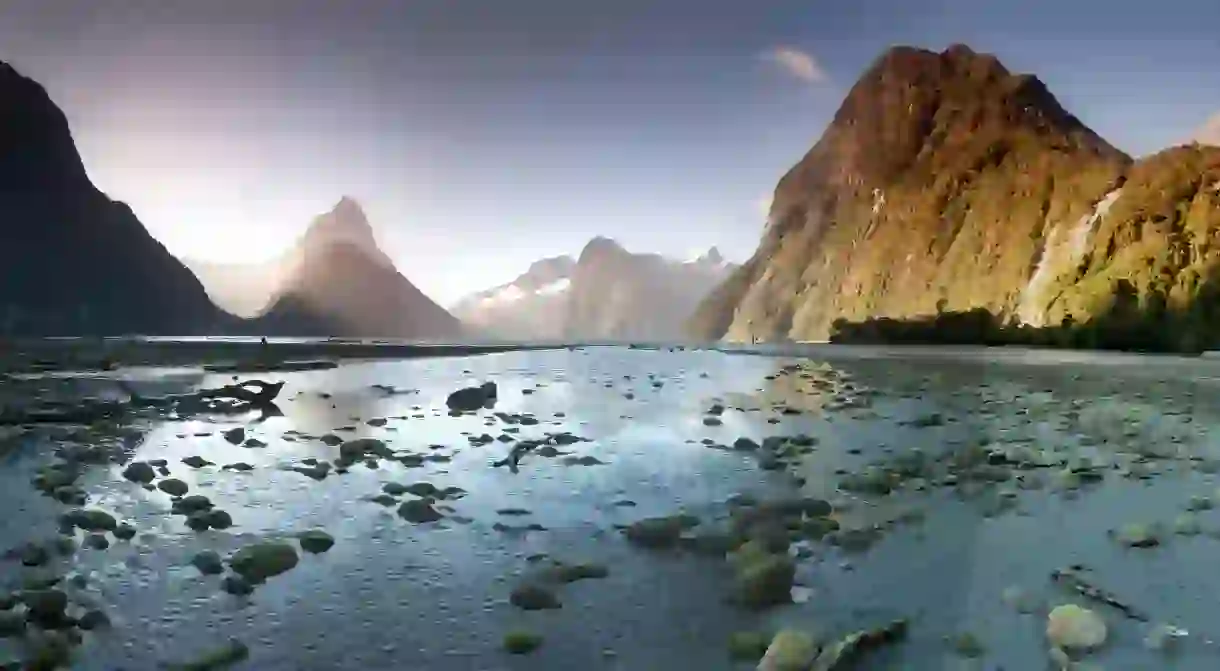A Guide to Visiting Milford Sound, New Zealand

Milford Sound is home to the finest natural landscapes the South Island has to offer. Rudyard Kipling famously described it as one of the wonders of the world – a fitting title for a place that sits at the heart of a UNESCO World Heritage site. If you’re eager to see this fantastic New Zealand attraction from up close, here are some practical tips for visiting.
When to go
Fiordland National Park, where Milford Sound is located, sees a high amount of rainfall throughout the year. For this natural environment, that is a very good thing: it’s what creates its thunderous waterfalls and allows the surrounding flora and fauna to flourish. Some might even say that a rainy day is one of the best times for seeing the area in all its glory.
The New Zealand summer (i.e. December-February) tends to be peak hiking season – if you want to visit around this time, you need to make sure to book your hike and accommodation well in advance. Average summer temperatures tend to be between 18-20C (64-68F), at times hitting a high of 27C (80F).
Generally, December and March-April are ideal for those seeking some temperate weather and fewer crowds. Autumn is also when the local wildlife, including penguins and seals, tend to be more active. Keep in mind that from May until mid-October (i.e. autumn through spring) the popular Milford Track is unregulated and most Department of Conservation (DOC) lodges are closed. Hiking around this time is not recommended unless you are highly experienced.
Because of the high influxes of precipitation, you should carry some rain wear and water-resistant gear at all times. Make sure to bring plenty of covered clothing, netting and bug repellent too – otherwise you might get bitten by sand flies. Humidity can be quite high during the warmer months, so make sure to bring lots of water and stay hydrated.

What to do
Hiking is a popular way to explore Milford Sound. The multi-day Milford Track is one of New Zealand’s Great Walks, and is the most highly sought-after route in the area. Shorter walking trails can be found in various noteworthy spots, including Key Summit, Humboldt Falls, Lake Marian and Lake Howden.
Cruises are a good option for sightseeing – especially if you want to get up close and personal with the waterfalls. The Milford Deep Underwater Observatory, the only one of its kind in New Zealand, can only be reached via cruise, too.
For an active, hands-on alternative, try kayaking: not only is this a good way to catch a glimpse of the wildlife, it also allows travellers to creep into the secluded little corners that a typical cruise is unable to reach.

How to get there
Remoteness is a big part of Milford Sound’s appeal. The nearest airport is in Queenstown, which is well served by regional flights from Wellington, Auckland and Christchurch, as well as international terminals across the globe.
The main options for getting into Milford Sound are as follows:
Fly
Milford Airport is quite small, servicing light aircraft in and out of Queenstown, Wanaka and Te Anau. It is a public airport that anyone with a pilot’s licence can use, and many tour operators and local aeroclubs regularly fly into it.
Flying in on a clear day is quite a good way to see the area’s picturesque attractions. Guided flight tours often include commentary on the history of the national park and its highlights, including the Mitre Peak, Stirling Falls and Sutherland Falls. Fiordland Helicopters is the main operator departing from Te Anau and Milford.
Take the Bus
Buses are a budget-friendly, stress-free option that allows travellers to really appreciate the dramatic South Island scenery. Most bus schedules are timed to coincide with cruise ship departures, too.
There are quite a few operators departing in and out of Milford Sound. Intercity has buses heading out of Queenstown and Te Anau every morning, reaching the final destination at lunchtime, and offer a few travel-pass options for the budget conscious. GreatSights, Gray Line and awesomeNZ are among the area’s best-renowned coach tour operators.
Drive
Milford Sound is approximately 288km (179mi) from Queenstown – a trip that takes approximately three and a half hours by car. Te Anau is closer – the 121-km (75.2-mi) drive takes around two hours. Cars, campervans and large tour coaches all share the same road, so to avoid the traffic, it is best to depart early in the morning (around 6am) or late in the day.
The Milford Road winds through the Homer Tunnel and is filled with picturesque spots. Highlights include the Mirror Lakes, as well as views of the Chasm and Hollyford.
There are no shops or petrol stations between Te Anau and Milford Sound, and the Milford Road has limited mobile phone coverage. Weather conditions can change drastically year-round, and carrying snow chains is a must if you’re driving in winter. Plan your trip carefully and keep an eye on the New Zealand Transport Authority page in case of road closures.

Where to stay
Freedom camping in Milford Sound is strictly forbidden. This is a protected heritage site, after all.
There is a campsite at Knobs Flat on Milford Road. Those doing the Milford Track need to book their place in the DOC huts, while others can stay at the only accommodation provider in Fiordland National Park, the Milford Sound Lodge, which caters for all travellers and budgets.
Overnight cruises are another option worth considering. Real Journeys is the main operator departing from Queenstown.
Many travellers opt to stay either in Te Anau or Queenstown for the night. Many day-tour operators offer complimentary pick-up and drop-off from selected hotels.














